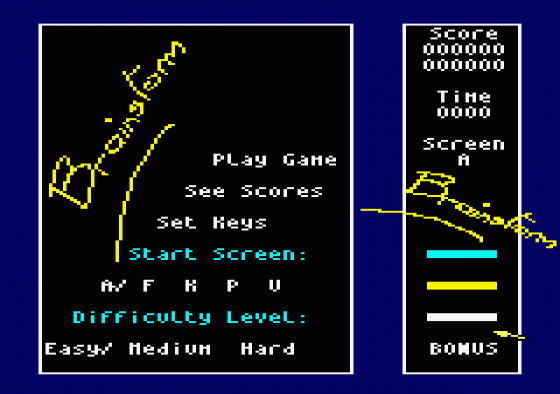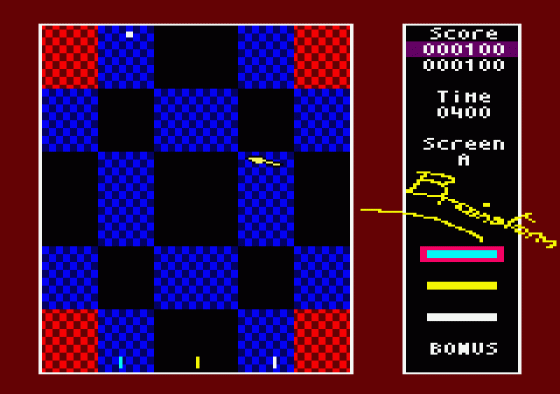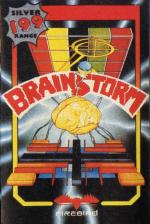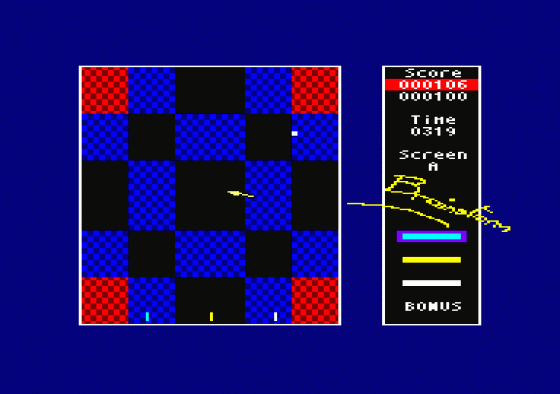
Amstrad Computer User
 1st August 1988
1st August 1988
Publisher: Firebird
Machine: Amstrad CPC464/664/6128
Published in Amstrad Computer User #45
Brainstorm
Pete Cooke programmed the highly-acclaimed arcade adventure Tau Ceti and its sequel Academy.
He's popped up again on the Firebird Silver Range budget label, collaborating with James Baird to produce Brainstorm.
The game is played on a grid composed of coloured squares. You control three coloured lines, yellow, light blue and white, which are moved about by an arrow.

After clicking an appropriate icon you connect the line to any point on the grid by moving the arrow over that point and pressing Fire.
But the line is of finite length; if you force it to be drawn to a distant point on the grid part of the line which you drew earlier will be erased.
The purpose of all this line shifting is to try and trap a ball which is bouncing around the screen. The subtle feature is that different coloured squares do different things when the ball passes over them.

Red squares increase your score by one, purple ones decrease your score by one, green ones cause the ball to jump randomly to other parts of the grid.
You start each screen with 100 points, and have 400 time units to play with. You don't necessarily have to trap the ball, but the condition for moving on to the next level is that, when your time runs out, you have more points at the end of the level you are on than you gained on the previous level. If this condition is not satisfied, the game ends.
The key to success is trapping the ball at the correct time on red squares and then using the Bonus icon. When Bonus is selected you are prevented from drawing any more lines, so you can't accidentally set the ball free.

There are 26 screens and a host of options. You can use keyboard, joystick or mouse to control the lines, and you can start on any of five different screens.
There are three skill levels. In increasing order of difficulty, you have three lines to trap one ball, then you have two lines, and finally you have three lines to trap two balls.
The colours are rather loud and the graphics are simple and blocky. But they are adequate, and you are too riveted to screen to worry about details like that. The omnipresent pointer moves very quickly and smoothly without a trace of flicker.

Although it's initially a little confusing and difficult to get to grips with, controlling the lines soon becomes second nature. Brainstorm is a good budget title.
Nigel
I have two mice at home. One usually lives in a large cage, and doesn't have a care in the world. The other is connected to my Amstrad, and was terrible bored. (It told me.)
Apparently, all it did was help with desktop publishing and other serious programs. Never got any time off for leisure. Until I got Brainstorm. Now it's whizzing around the table with relish.

It's enjoying itself, and so will you.
Colin
If you're tired of blowing nasties to bits, Brainstorm will blow the cobwebs from your brain. The philosophy behind it reminds me of Confuzion - lots of thought needed, with the occasional frantic repair job when you find the time limite running low. You will quickly be hooked.
But, oh dear - the game is unplayable with a green screen monitor. The greens, reds and purples are not distinctive enough.
Liz
Crude, blocky graphics, violent colours grabbed straight from the Spectrum's restricted palette - and who cares? A deceptively simple game that is horribly addictive and also non-violent, which should please many people.
The programmers have certainly taken a bold step in using classical music for the title tune, rather than going for the current trend of producing poor copies of rock music. More strings to their bow!




